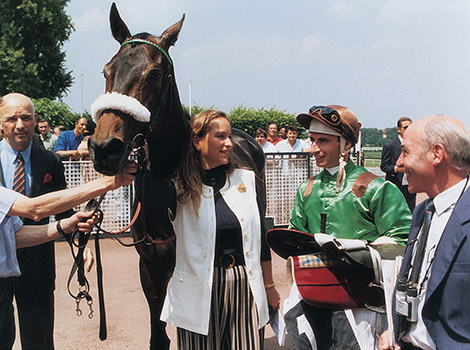
She did not score again but acquired "black type" through being placed in the Prix Minerve, a Group III race won by her dam Daralinsha. By a felicitous chance Daralbayda traces to one of the great Boussac foundation mares, the suitably named Pretty Lady, dam of the dual Champion Stakes winner Dynamiter and a family that had been introduced into the Aga Khan’s Studs by her father. Retired to stud in 1997, she has so far bred four fillies including Darinska, by Zilzal, who won impressively on her debut before finishing third in the Gr III Prix de Royaumont and second in the Listed Prix des Tourelles in 2002. Darinska’s sister Darkara won that same Listed race two years later. Both form part of the Aga Khan broodmare band and their products belong and run in Princess Zahra Aga Khan’s name. Darinska’s first product was none other than triple Group I winner Darjina (Poule d’Essai des Pouliches, Prix d’Astarté and Prix du Moulin de Longchamp), who has now also entered the Aga Khan Studs’ broodmare band.
The Princess also enjoyed early success in Ireland in 1997, when John Oxx saddled her first runner Khatara. Starting favourite in a field of twenty-one, this daughter of Green Desert came from behind to win by a length. She subsequently achieved a Listed race placing when 2nd in the Brownstown Stud Stakes. Brownstown itself forms part of Sheshoon.
Her third mare was Mandalara a winning half-sister to dual Grade I winner Manndar. She was retired to stud in 2001 and produced Mandesha as her second foal, a filly who was to become a triple Group I winner (Prix d’Astarté, Prix Vermeille and Prix de l’Opéra). Although Mandalara was sold, the Princess retained her daughter Mandesha who is now at stud and has produced amongst others a promising colt Mandour, her first foal. Culling is a necessary method for a breeding operation of this size, in order to keep numbers at an equal level; Princess Zahra Aga Khan thus remains true to her ancestors’ historical operation by operating along these same lines.
An enthusiastic horse-woman, the Princess has gained a valuable insight into the manner in which sires are selected through partaking in the annual round table discussions that involve her father and the stud managers. Just over a decade after she picked her first filly Daralbayda, Princess Zahra’s original broodmare band had lifted five black-type performers, including two Group I winning fillies. The next generation may now be ready to fill further promise.
For racing silks the Princess has opted to blend together styles and shades associated with past family success. The French colours have always featured green with red epaulettes and a green cap whereas the original English and Irish colours were green and chocolate hoops with a chocolate cap. However, with "chocolate" no longer in use, she has elected to register her silks as emerald green and brown epaulettes with a brown cap.